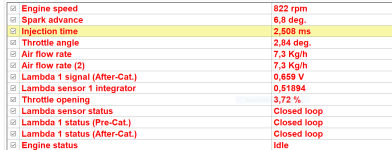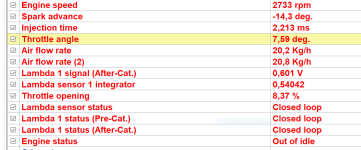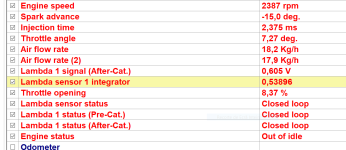crankshaft
Member
- Joined
- Feb 13, 2017
- Messages
- 136
- Points
- 87
My Punto from 2002, failed the emissions test. I was told the CO was too high.
The emissions test is done in 2 parts. Part one with the car idling. Part two reving up the engine between 2000 and 3000 RPMS.
The CO was high in both cases.
The car drives fine, and idles fine.
However, at idle, when I rev up the engine, I can't keep the car at a fixed rpm value.
I can't keep the revs steady at 2500 RPM they start going up without inputting any change to the the gas pedal. And the ECU reports that it is in closed loop.
I connect MultiECUScan and I can see the throttle position increasing without any changes to the gas pedal, they start going up, then stop going up and start hunting around a value, and never stay steady.
I have no idea where to go from here, the car idles fine, which makes me think the throttle body is working good. It seems that the ECU commands it to open more, even though I didn't press the gas pedal more.
This only happens when the engine has no load. I went for a drive, with MultiECUScan connect, and I don't see any changes to the throttle position, that don't match the gas pedal.
I took 3 screenshots of MultiECUScan. One of the images is with the engine at idle. Two of the images are when reving up the engine to 2500 with the car at idle, that is stopped, no engine load.
The screenshots also show the lambda sensors status, and the ignition timing and throttle position.
Is there a relation between high CO levels - at idle and when reving at around 2500RPM - and this symptom also happening at idle that the engine won't keep the RPMs steady?
I don't know how to interpret the Lambda Integrator value.
I can see the spark advance goes negative when I rev up the engine, I don't know if that's normal.
The injection times seem very close, at idle, or when reving up, but I also don't know if they are high.
The emissions test is done in 2 parts. Part one with the car idling. Part two reving up the engine between 2000 and 3000 RPMS.
The CO was high in both cases.
The car drives fine, and idles fine.
However, at idle, when I rev up the engine, I can't keep the car at a fixed rpm value.
I can't keep the revs steady at 2500 RPM they start going up without inputting any change to the the gas pedal. And the ECU reports that it is in closed loop.
I connect MultiECUScan and I can see the throttle position increasing without any changes to the gas pedal, they start going up, then stop going up and start hunting around a value, and never stay steady.
I have no idea where to go from here, the car idles fine, which makes me think the throttle body is working good. It seems that the ECU commands it to open more, even though I didn't press the gas pedal more.
This only happens when the engine has no load. I went for a drive, with MultiECUScan connect, and I don't see any changes to the throttle position, that don't match the gas pedal.
I took 3 screenshots of MultiECUScan. One of the images is with the engine at idle. Two of the images are when reving up the engine to 2500 with the car at idle, that is stopped, no engine load.
The screenshots also show the lambda sensors status, and the ignition timing and throttle position.
Is there a relation between high CO levels - at idle and when reving at around 2500RPM - and this symptom also happening at idle that the engine won't keep the RPMs steady?
I don't know how to interpret the Lambda Integrator value.
I can see the spark advance goes negative when I rev up the engine, I don't know if that's normal.
The injection times seem very close, at idle, or when reving up, but I also don't know if they are high.
Attachments
Last edited:




